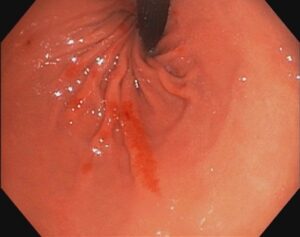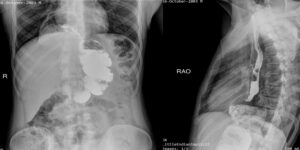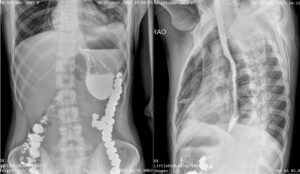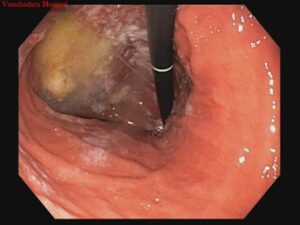Ramprashanth MP1, Vinay HG1*, Naveen N1
1Department of General Surgery, Vamshodaya Hospital, Kolar, Karnataka, India
*Correspondence author: Vinay HG, MS General Surgery, FSGE, Department of General Surgery, Vamshodaya Hospital, Kolar, Karnataka, India;
Email: [email protected]
Published On: 20-03-2024
Copyright© 2024 by Ramprashanth MP, et al. All rights reserved. This is an open access article distributed under the terms of the Creative Commons Attribution License, which permits unrestricted use, distribution and reproduction in any medium, provided the original author and source are credited.
Abstract
Background: Gastric volvulus, a rare surgical emergency mimics common presentations like acute pancreatitis. Intestinal obstruction and hollow viscous perforation.
Clinical Description: A young male without any co-morbidities presenting with acute pain in the abdomen with vomiting for 5 days with stable vitals.
Management: Erect abdominal X-ray with diagnostic endoscopy was done on an emergency basis. Laparoscopic repair of the hiatal hernia with anterior gastropexy was performed immediately.
Conclusion: Early diagnosis of acute abdominal pain is crucial as misdiagnosis delays proper treatment. Aspiring surgeons should acknowledge that while diagnosing rare disorders may often be challenging, there is a possibility of accuracy in specific cases.
Keywords: Laparoscopy; Anterior Gastropexy; Borchardt Triad
Introduction
Gastric volvulus is a rare surgical emergency presenting as acute pain in the abdomen. Borchardt in 1905, had highlighted a classical triad that is seen in up to 70% of the patients. The features of Borchardt triad include epigastric pain, retching with the inability to vomit and inability to pass the Ryle’s tube. The presentation of gastric volvulus is similar to other acute conditions like intestinal obstruction, hollow viscous perforation and acute pancreatitis. Hence it becomes imperative to distinguish and accurately diagnose the condition which has a high mortality (30-50%) [1].
Gastric volvulus is an uncommon condition that is frequently overlooked that results in severe complications, particularly strangulation accompanied by ischemia and gastric necrosis. This underscores the significance of prompt detection, which relies on a comprehensive understanding of this condition in all its facets.
Case Report
A 20-year-old male patient presented to our emergency department with complaints of epigastric pain for 5 days, insidious in onset, dull aching in type, with no aggravating or relieving factors. It was associated with non-projectile vomiting which soon progressed to a non-productive type. His medical background was unremarkable, with no co-morbidities except for similar complaints in the past month. He denied any surgical history.
Upon initial physical examination, the patient presented with stable vital signs and a flaccid abdomen without peritonitis signs, masses, or visceromegaly. On, auscultation of the three were decreased breath sounds on the right lung. The rectal examination was done which showed a normal sphincteric room with collapsed walls. Initial baseline investigations were performed in an emergency basis and was reported to be within normal limits. Serological markers of HIV and HBsAg were negative.
As the patient had clinical signs of upper gastrointestinal obstruction, he was immediately taken for an erect abdominal X-ray which showed the stomach occupying the right thoracic cavity. An upper gastrointestinal diagnostic endoscopy (Fig. 1) was done which showed organoaxial rotation of the stomach with para-esophageal hernia. The patient was thus prepared and shifted for emergency laparoscopic repair of the hiatal hernia with anterior gastropexy. During the procedure, organoaxial gastric volvulus was seen. A large hiatal defect with herniation of the transverse colon was detected along with a few adhesions. Postoperatively, Ryle’s tube aspiration was done and the patient was started on oral feeds from post-op day 3. Erect abdomen X-ray was repeated. (Fig. 2,3). Endoscopy was done postoperatively (Fig. 4) and was discharged with antibiotics and advised high fibre diet.

Figure 1: Upper GI endoscopy.

Figure 2: Preoperative erect abdomen X-ray.

Figure 3: Post operative erect abdomen X-ray.

Figure 4: Post operative endoscopy.
Discussion
Gastric volvulus is defined as the rotation of the stomach on the long axis, short axis or a combination of both. “Volvulus” is derived from the Latin volvere and refers to “roll or turn”. Since its discovery by Berti in 1866, while performing a postmortem on the body of an old lady, only about 400 cases have been reported so far and only 43 were reported in PubMed from 1999 to 2018 [2,3].
The peak incidence of gastric volvulus is in the fifth decade of life. It is seen in association with paraesophageal hernia while, in approximately 20% of the cases occurs in infants under 1 year secondary to congenital diaphragmatic defects [2]. Gastric volvulus is anatomically classified with the presence or absence of diaphragmatic defects into primary and secondary. However, the most accepted classification is by Singleton based on the axis of rotation [4]:
- Organoaxial – rotation around long axis (coronal plane), most common (59%) [5]
- Mesentero-axial – rotation of stomach from right to left or left to right (long axis of the gastrohepatic omentum)
- Combination of both – very rare phenomenon
The risk factors for gastric volvulus include hiatal hernias, elevation of the diaphragm, trauma to the diaphragm, gastric ulcer or malignancy, diaphragmatic paralysis due to phrenic nerve injury and extrinsic pressure to the stomach due to enlarging abdominal organs. Gastric volvulus occurs when one or more of the risk factors are combined with the laxity of the suspensory ligaments of the stomach [5].
The signs and symptoms of gastric volvulus are based on the rapidity of onset, degree of rotation and obstruction and its anatomical classification. The abdominal pain is severe and is usually localized to the upper abdomen or lower chest. On examination, the upper abdomen is often distended and tympanic to percuss and the lower abdomen is usually soft and non-distended. In secondary volvulus, the pain mimics a myocardial infarction where there is pain in the chest radiating to the back and shoulders and is associated with dyspnea. Though vomiting is also seen, it soon progresses to non-productive retching [2].
Though Borchardt had given the typical triad, Carter, et al., suggested additional findings [6]:
- Minimal abdominal findings as the stomach are in the thorax
- Gas-filled viscous in the lower chest/abdomen in the chest radiograph (“upside-down stomach”)
- obstruction at the site of the volvulus evidenced by upper Gastrointestinal (GI) series
Though a radiograph depicting intrathoracic viscous is substantial, the initial diagnosis is always clinical. There are no specific laboratory tests to confirm the diagnosis and can sometimes be misleading. A study by Williams et al. reported 2 cases of gastric volvulus with raised serum amylase levels (exceeding 1000 IU/L) and were misdiagnosed as acute pancreatitis [7].
Abdominal X-rays in supine and erect positions show spherical stomach and double air-fluid levels respectively, Abdominal CT scan is usually diagnostic of gastric volvulus [5].
Though differentials for gastric volvulus seem to be more common for the acute presentation, it is crucial that this diagnosis is not missed. Early recognition and diagnosis are vital in decreasing the high mortality associated with gastric volvulus. Conservative management can be employed in the treatment of gastric volvulus in mesentero-axial rotation as cardia is open and a nasogastric tube can be inserted for decompression. However, in other cases with an inability to pass the nasogastric tube and also in patients with chronicity of volvulus, a surgical procedure is mandatory. Tanner had suggested anterior gastropexy with colonic displacement where the colon is freed from the greater curvature of the stomach and is allowed to occupy the subdiaphragmatic space and the greater curvature is fixed to the anterior abdominal wall [8].
Complications are often due to delayed recognition and initiation of treatment. Strangulation is the most common complication despite abundant vasculature of the stomach. Rarely, injuries to the spleen are also seen when the vessels supplying it are torn by the rotation of the stomach, resulting in haemorrhage and splenic rupture. Other complications include ulceration, perforation, pancreatic necrosis and omental evulsion [9,10].
Conclusion
It is crucial to diagnose cases presenting as acute pain abdomen as early as possible. Misdiagnosis will delay the administration of the proper treatment and consequentially affect subsequent prognosis including mortality and morbidity. Young aspiring surgeons should bear in mind that while diagnosing cases involving rare disorders may make them seldom correct, there is a chance that they are accurate this time.
We should consider gastric volvulus as a potential diagnosis when encountering sudden epigastric discomfort accompanied by vomiting or difficulty breathing, particularly in individuals with a history of diaphragmatic hernia or ongoing digestive issues.
The preferred management is by immediate surgical intervention, involving untwisting the stomach, repositioning it and addressing the underlying cause.
Conflict of Interests
The authors have no conflict of interest to declare.
References
- Lopez PP, Megha R. Gastric Volvulus. In: StatPearls. StatPearls Publishing; 2023. [Last accessed on: March 13, 2024] http://www.ncbi.nlm.nih.gov/books/NBK507886/
- Godshall D, Mossallam U, Rosenbaum R. Gastric volvulus: case report and review of the literature. J Emerg Med. 1999;17(5):837-40.
- Akhtar A, Siddiqui FS, Sheikh AAE, Sheikh AB, Perisetti A. Gastric Volvulus: A Rare Entity Case Report and Literature Review. Cureus. 2018;10(3):e2312.
- Singleton AC. Chronic gastric volvulus. Radiology. 1940;34(1):53-61.
- Jabbour G, Afifi I, Ellabib M, El-Menyar A, Al-Thani H. Spontaneous acute mesenteroaxial gastric volvulus diagnosed by computed tomography scan in a young man. Am J Case Rep. 2016;17:283-8.
- Carter R, Brewer LA, Hinshaw DB. Acute gastric volvulus. The American J Surg. 1980;140(1):99-106.
- Williams L, Lansdown MR, Larvin M, Ward DC. Gastric volvulus: a rare cause of hyperamylasaemia. Br J Clin Pract. 1990;44(12):708-9.
- Tanner NC. Chronic and recurrent volvulus of the stomach with late results of colonic displacement. Am J Surg. 1968;115(4):505-15.
- Haddad JK, Doherty C, Clark RE. Acute gastric volvulus endoscopic derotation. West J Med. 1977;127(4):341-6.
- Giblin TR, Martin JD. Volvulus of the stomach. Am Surg. 1960;26:759-62.
Article Type
Case Report
Publication History
Received On: 16-02-2024
Accepted On: 13-03-2024
Published On: 20-03-2024
Copyright© 2024 by Ramprashanth MP, et al. All rights reserved. This is an open access article distributed under the terms of the Creative Commons Attribution License, which permits unrestricted use, distribution, and reproduction in any medium, provided the original author and source are credited.
Citation: Ramprashanth MP, et al. Gastric Volvulus with Hiatal Hernia in a Young Male: A Case Report. J Surg Res Prac. 2024;5(1):1-5.

Figure 1: Upper GI endoscopy.

Figure 2: Preoperative erect abdomen X-ray.

Figure 3: Post operative erect abdomen X-ray.

Figure 4: Post operative endoscopy.


